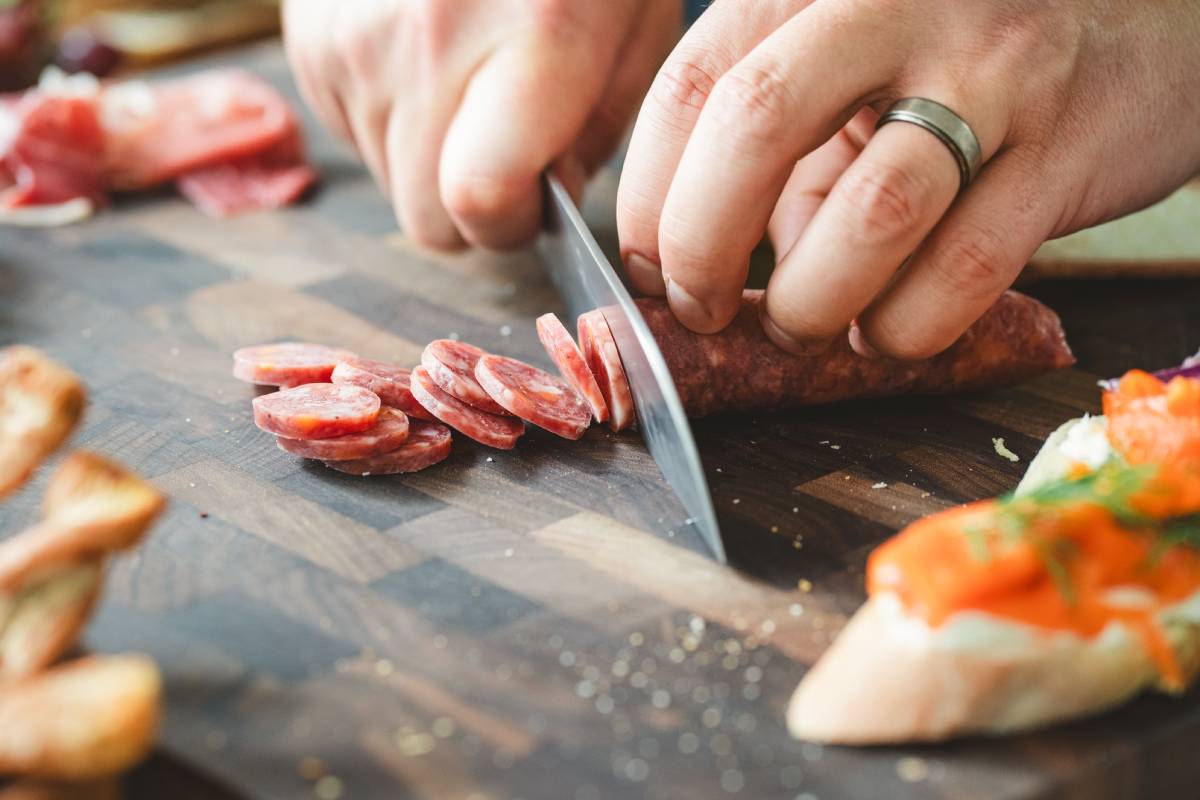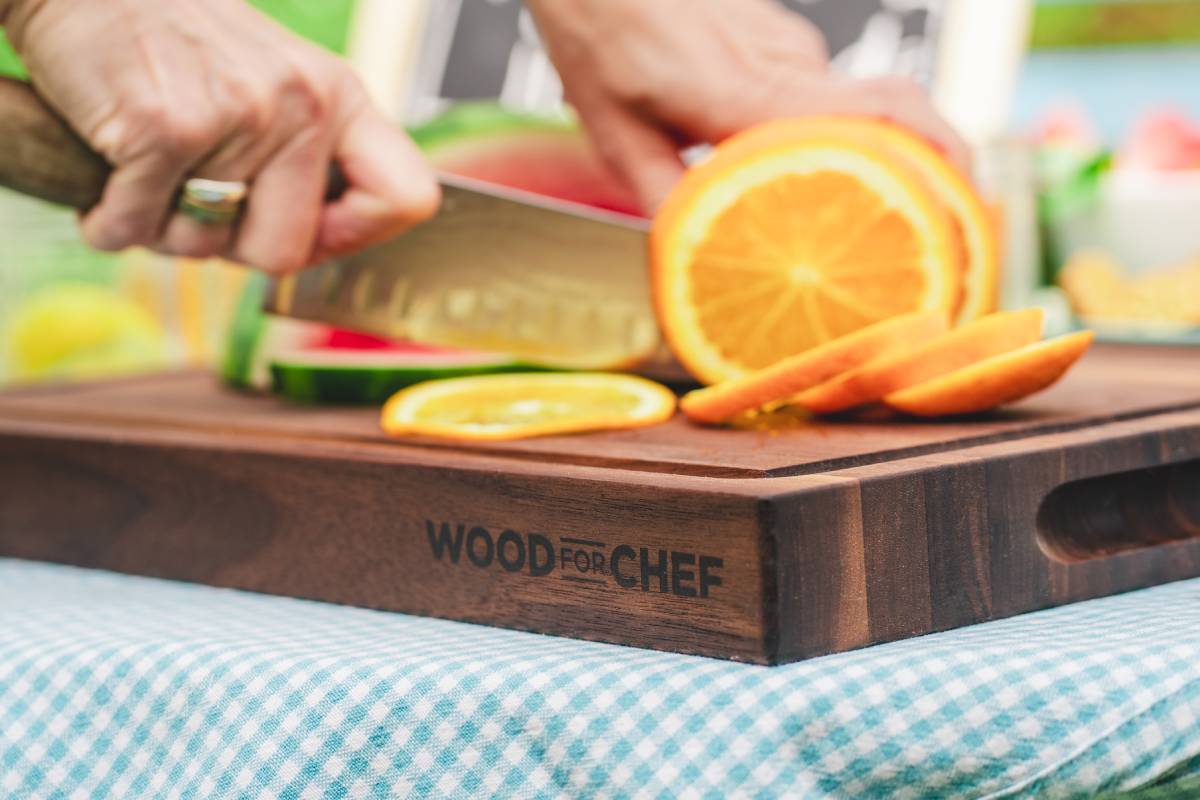A butcher block isn’t just another kitchen tool—it’s a handcrafted surface built to handle daily meal prep, chopping, and serving with grace. When properly maintained, a high‑quality wood butcher block becomes an heirloom piece that looks better over time. Neglected surfaces, on the other hand, can warp, crack or harbor bacteria. This guide explains how to keep your butcher block in peak condition and prevent avoidable damage, drawing on the expertise of WoodForChef®, a company known for premium, sustainably sourced boards and blocks.
Why butcher blocks need special care
Butcher blocks differ from thin cutting boards in both construction and purpose. While many cutting boards are quarter‑inch‑thick planks, butcher blocks are thick (often 1½–2½ inches) slabs made from hardwood end grain or edge grain. These boards are designed to absorb heavy impacts from cleavers and to stay stable on a countertop. Because they’re thicker, they need a regimen that keeps the wood fibers hydrated yet protected from excessive moisture. Proper cleaning and conditioning also prolong the natural antibacterial properties of wood.
Daily cleaning routine
Clean after each use
Wash your butcher block immediately after each use to remove food residues, odors and bacteria. The WoodForChef care guide recommends wiping the board with a clean, damp cloth and using mild soap with lukewarm water to tackle stubborn stains. Avoid strong chemicals such as bleach; they can dry out the wood and strip the natural oils that protect it.
After washing, dry the block thoroughly with a towel and then allow it to air‑dry upright on its edge. Trapped moisture is the enemy of wood. If water sits on the surface too long, it can cause swelling and warp the block.
Avoid submerging the block
Never soak or submerge a butcher block in water. Submersion causes the fibers to absorb too much water, which leads to swelling, warping and cracking. Even a quick dunk in a sink can cause long‑term damage. Instead, wash the surface with running water and a sponge, then dry it immediately.
Sanitizing without harsh chemicals
To sanitize a butcher block without damaging it, sprinkle coarse salt or baking soda over the surface and rub with a cut lemon. The citric acid neutralizes odors and kills bacteria naturally. Rinse with a damp cloth and dry immediately. Vinegar diluted with water is another natural disinfectant; spray it on the board, let it sit for a few minutes and wipe dry. These methods preserve the wood’s integrity and avoid the strong chemicals that strip oils.
Rotate and use proper knives
Even though butcher blocks can take a beating, using smooth‑bladed knives instead of serrated knives reduces deep scoring in the wood. Serrated blades tear through fibers and leave marks that are hard to sand out. Rotating the block between uses also prevents uneven wear; by alternating cutting zones, you allow the fibers in previously used areas to rest and rebound.
Oiling your butcher block
Wood is hygroscopic—it absorbs and releases moisture from the environment. Oiling saturates the fibers so that the board won’t absorb water or odors from food. Without regular oiling, the surface dries out, leading to cracks, splitting and harboring of bacteria.
Why oil matters
WoodForChef emphasizes that maintenance oil prevents dehydration, protects against water penetration and staining, and keeps the wood’s appearance rich and lustrous. An oiled surface forms a protective barrier that repels liquids, resisting stains from wine, fruit juices and sauces. Oiling also enhances the natural grain and color of your butcher block.
How often to oil
For new blocks, oil once per day for the first week, then once per week for the first month to build up the protective barrier. After that, oil every three to four weeks or whenever the surface looks dry and chalky. Seasonal humidity swings may require more frequent oiling in winter when indoor air is dry.
Choosing the right oil
Not all oils are created equal. WoodForChef’s Food Grade Mineral Oil is 100 % natural, N.S.F.- and F.D.A.-certified. Mineral oil does not go rancid or oxidize, making it ideal for food contact surfaces. The care guide warns against using vegetable, corn, olive, peanut or walnut oils because the fats oxidize and go rancid over time. Do not use standard mineral oil from a hardware store, as it may not be food‑safe and is meant for mechanical lubrication. For added conditioning and a silky finish, you can follow mineral oil with a food‑safe beeswax‑based board cream; the wax locks in moisture and adds extra water resistance.
Application technique
- Warm the oil slightly (placing the bottle in warm water for a few minutes) to improve penetration.
- Apply generously with a clean lint‑free cloth or paper towel, rubbing along the grain. Cover all surfaces, including edges and handles.
- Let it absorb for at least 20–30 minutes. If the wood drinks up the oil quickly, apply another coat.
-
Wipe off excess with a dry cloth. The surface should feel smooth and slightly oily, not sticky.
Perform this oiling routine after deep cleaning, when the board is completely dry.
Preventing and repairing damage

Dealing with stains and odors
Regular oiling repels stains, but sometimes a beet juice or garlic odor lingers. For stubborn stains, sprinkle coarse salt or baking soda and rub with a lemon. For deep stains, sand the affected area lightly with 220‑grit sandpaper and re‑oil. To neutralize odors, place a paste of baking soda and water on the surface for a few hours, then wipe clean and dry.
Preventing knife scars
Use smooth‑bladed knives whenever possible and avoid heavy hacking with serrated blades. Serrated edges create deep gouges that not only mar the appearance but also trap food particles and bacteria. Always use a separate surface for cutting bones or extremely hard materials; a cleaver can damage any wooden board if misused. Rotating the board regularly distributes wear evenly across the surface.
Protecting against water and heat
Keep butcher blocks away from dishwashers, sinks, and direct heat sources such as stovetops or ovens. Excess moisture causes swelling and warping, while heat dries out the wood and leads to cracks. Use trivets for hot pans and never place a pot straight from the stove onto the block.
Resurfacing a worn board
If your block develops deep cuts or an uneven surface, resurfacing can restore it. Start by sanding with coarse (80‑ to 100‑grit) sandpaper to remove deep scars, then progressively move to finer grits (150‑, 220‑grit) until the surface is smooth. Wipe away dust with a damp cloth, let it dry completely and apply multiple coats of mineral oil as described above. Severe cracks or broken boards should be repaired by a professional woodworker.
WoodForChef products to enhance longevity
High‑quality boards start with high‑quality materials. WoodForChef sources premium hardwoods—including maple, walnut and cherry—that are sustainably harvested and FSC certified. These woods offer the durability and moisture resistance needed for butcher blocks while being gentle on knives.
Butcher Block Pro
The Butcher Block Pro from WoodForChef is a thick, reversible block built for professional and home cooks alike. It features beautifully joined hardwood pieces that provide a stable cutting surface and attractive grain patterns. The block’s edge‑grain construction balances durability with knife friendliness; the fibers compress under knife pressure and then rebound, keeping your knives sharper longer.
Why we love it: The Butcher Block Pro is available in walnut, maple and cherry. Walnut offers rich dark tones with excellent moisture resistance, maple boasts a tight grain and light color that enhances patina with age, and cherry delivers a balance of softness and strength that’s perfect for precision work. Each block is reversible and finished with food‑safe oil, ready for your first cook.
Food Grade Mineral Oil
WoodForChef’s Food Grade Mineral Oil is specifically formulated for wooden boards. It contains 100 % natural mineral oil and is certified by N.S.F. and F.D.A.. The oil penetrates deeply to hydrate the wood fibers, preventing dehydration, stains and odors. Since it does not oxidize, it will not leave a rancid smell. The bottle’s 250 ml size is enough to maintain a standard board for months and features an easy‑pour design.
Complementary care products
In addition to mineral oil, a wood conditioner combining mineral oil and beeswax can provide added protection. The wax forms a harder layer on the surface that repels moisture and gives the board a satin sheen. For deep cleaning before oiling, consider a board scrub made from natural coconut fibers, which gently lifts stuck‑on food without scratching the wood.
Sustainability and trust
Responsible sourcing matters. WoodForChef uses FSC‑certified wood from responsibly managed forests. FSC certification ensures that harvesting practices protect biodiversity, respect workers’ rights and support local communities. Choosing sustainable products contributes to forest conservation and aligns with the principles of environmental stewardship.
Trust is also about the experience and expertise behind the brand. According to Google’s Search Quality Evaluator Guidelines, content that demonstrates Experience, Expertise, Authoritativeness and Trust (E‑E‑A‑T) is more likely to be considered high quality. WoodForChef’s long history of crafting wooden kitchenware gives them firsthand experience in what makes a block durable and safe. Their products are backed by certifications and positive customer reviews, and their care instructions are transparent and evidence‑based. When following maintenance advice, consider the source’s expertise: recommendations from the manufacturer carry weight because they know their materials intimately.
Conclusion
A well‑maintained butcher block is more than a cutting surface—it’s a centerpiece of your kitchen and a statement of craftsmanship. By following a consistent cleaning routine, oiling regularly with food‑safe mineral oil and avoiding misuse, your WoodForChef butcher block will serve you beautifully for years. Sustainable sourcing and thoughtful design ensure that you’re not only investing in quality but also supporting responsible forestry practices. With the right care, your butcher block will develop a rich patina, remain gentle on your knives and continue to be a reliable companion in your culinary adventures.
To explore more, visit the WoodForChef butcher block collection for various sizes and wood species. Pair your chosen block with their Food Grade Mineral Oil and embrace the ritual of caring for an heirloom piece that brings warmth and function to your kitchen.

